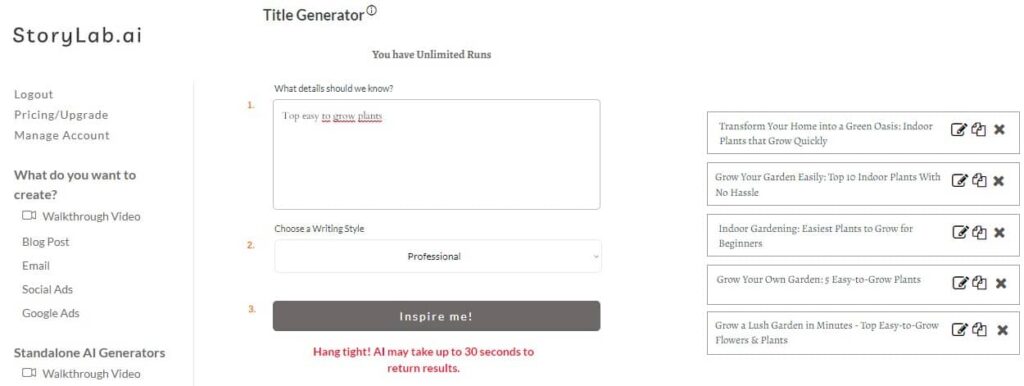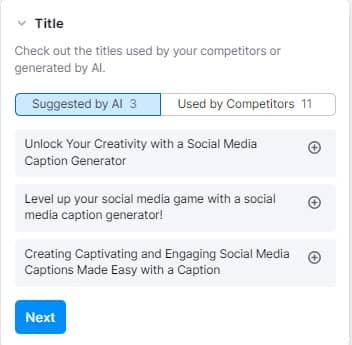Catchy Gardening Blog Post Title Examples [+ Free AI Tools]
Create Catchy Blog Post Titles for your Garden Blog or Website with our examples and the Free AI Blog Title Generators.

Grow your Gardening Blog’s website traffic by creating better catchy and engaging blog post titles.
Check out our tips and tools and start improving today.
In this article
- Why should Gardening Blogs Write Great Blog Post Titles?
- AI Tool for Gardening Blogs to Write Great Blog Post Titles
- Benefits the AI-Powered Blog Title Generator
- AI Blog Title Generator by Semrush (ContentShake)
- SEO Optimize your Blog Post Title
- Catchy Gardening Blog Post Title Examples
- Top AI Blog Title Generators
- Best Practices Blogging for Gardening Blogs
- Other Catchy Blog Title Examples
Why should Gardening Blogs Write Great Blog Post Titles?
Gardening blogs should write great blog post titles for several reasons:
- Grabbing Attention: A great blog post title can grab the attention of readers and make them more likely to click and read the post. In today’s world, where there is a lot of online content, an eye-catching and interesting title can help your gardening blog stand out.
- Enhancing SEO: A well-crafted blog post title can also help with search engine optimization (SEO) by including relevant keywords that people are searching for. This can help your post rank higher in search engine results and bring more traffic to your gardening blog.
- Encouraging Sharing: When people find a blog post with a catchy title that they enjoy, they are more likely to share it on social media or with friends and family. This can help your gardening blog reach a wider audience and attract more readers.
- Creating Brand Identity: Consistently using great blog post titles can help create a strong brand identity for your gardening blog. If your titles are consistently interesting and engaging, readers will come to expect that from your blog and be more likely to return for future content.
Overall, writing great blog post titles is a simple yet effective way for gardening blogs to attract readers, enhance SEO, encourage sharing, and build a strong brand identity.
AI Tool for Gardening Blogs to Write Great Blog Post Titles
In order to come up with the best headline for your next Gardening article, you’ll need to create a list of potential titles and then select the best one. To help speed up that process and to improve creativity, check out how an AI-Powered Blog Title Generator can help.
You simply enter what your blog post is about, choose a writing style, and click the ‘Inspire me!’ button. Here’s what that looks like:
For this example we’ve used the input:
‘Top easy to grow plants’

Benefits the AI-Powered Blog Title Generator
At a glance, here’s what the Blog Title Generator can do for you.
| 🤖AI modes | 13 writing styles |
 Improves Improves |
blog content, creativity, and more |
| 🦾Supports | 17+ Languages |
 Price Price |
Free and Premium |
AI Blog Title Generator by Semrush (ContentShake)
Semrush is a Keyword research tool and they´ve created ContentShake to go from insights (keyword research) to content ideas and to full-written articles in minutes. ContentShake comes with a free trial so you can see if you like this AI Blog Title Generator better than other AI tools and select the one that fits your content creation processes best. Be sure to try it out and see if you love it.
Here’s what their AI Blog Title Generator insights look like. They give you 3 suggestions for your article and show the titles your competitors are using for that given keyword.

SEO Optimize your Blog Post Title
Next to creating a catchy blog post title, you also want to include the right keyword and optimize it for SEO. Preferably, you should add your main keyword at the start of your H1 and Meta Title. For this article, we’ve added our main keyword ‘Gardening Blog Post Title Exampels” at the start.
Don’t guess which keywords to use. Use tools like SEMRush to find what people are actually searching for. Simply enter your topic, get a ton of data and select the best keyword based on volume and difficulty. Try it for free and get the data you need.
Check out the video and learn how to do keyword research with Semrush:
Catchy Gardening Blog Post Title Examples
- 10 Secrets to Growing Perfect Tomatoes
- Creating a Beautiful Butterfly Garden: Tips and Tricks
- 5 Must-Have Tools for Your Garden Shed
- The Benefits of Container Gardening: Small Space, Big Impact
- The Best Time to Plant Your Garden for Optimal Growth
- Garden-to-Table: Fresh Recipes for Your Homegrown Produce
- 10 Tips for Successful Composting at Home
- How to Build a DIY Garden Pond
- The Zen of Gardening: Finding Peace in Your Garden
- Growing Herbs Indoors: Tips for a Thriving Herb Garden
- The Beauty and Benefits of Companion Planting
- Gardening for Wildlife: Creating a Habitat for Birds and Bees
- How to Create a Garden on a Budget
- The Importance of Soil Health: Tips for Improving Your Soil
- Gardening with Kids: Fun and Educational Projects
- Top 10 Flowers for a Beautiful Spring Garden
- The Healing Power of Gardening: Mental Health Benefits
- 5 Low-Maintenance Plants for Busy Gardeners
- Creating a Sensory Garden: Engaging All Five Senses
- The Art of Pruning: Tips for Keeping Your Plants Healthy
- 10 Unique Garden Decor Ideas to Elevate Your Space
- How to Grow Your Own Vegetable Garden: A Beginner’s Guide
- The Benefits of Raised Bed Gardening: Why You Should Try It
- Garden Design 101: Principles for a Stunning Outdoor Space
- 10 Tips for Growing Beautiful Roses
- The Magic of Edible Flowers: Recipes and Growing Tips
- The Joy of Seed Starting: Tips for Success
- How to Attract Pollinators to Your Garden
- 10 Water-Wise Gardening Tips for a Sustainable Landscape
- The Dos and Don’ts of Lawn Care
- Growing Your Own Tea Garden: Tips and Recipes
- The Power of Plants: Healing Herbs and Their Uses
- 10 Tips for Growing Healthy Houseplants
- Creating a Drought-Tolerant Garden: Tips and Ideas
- How to Build a Vertical Garden: A DIY Guide
- Garden Photography: Tips and Tricks for Capturing Beautiful Images
- 10 Tips for Growing Perfect Peppers
- The Importance of Garden Planning: How to Get Started
- Gardening for Small Spaces: Ideas for Apartment Dwellers
- 10 Tips for Dealing with Garden Pests and Diseases
- Creating a Secret Garden: Tips for a Cozy Hideaway
- The Beauty and Benefits of Native Plants
- 10 Tips for Successful Seed Saving
- Gardening for Self-Sufficiency: Growing Your Own Food
- How to Create a Bee-Friendly Garden
- 10 Tips for Growing Beautiful Cut Flowers
- The Importance of Mulching: Tips for a Healthy Garden
- Gardening with Succulents: Tips for a Low-Maintenance Garden
- The Joy of Garden Art: Ideas for Adding Beauty to Your Space
- 10 Tips for Growing Healthy Tomatoes in Containers
- The Benefits of Perennial Gardening: How to Create a Sustainable Landscape
- Creating a Rock Garden: Tips and Inspiration
- 10 Tips for Growing Beautiful Hydrangeas
- The Healing Power of Aromatherapy
- 10 Easy Tips for Growing Your First Vegetable Garden
- The Secret to a Beautiful Flower Garden
- 5 Surprising Benefits of Gardening for Your Health
- How to Create a Low-Maintenance Garden
- The Top 10 Must-Have Garden Tools
- Gardening on a Budget: Tips and Tricks
- 10 DIY Garden Projects to Spruce up Your Outdoor Space
- The Ultimate Guide to Composting
- 5 Creative Ways to Use Recycled Materials in Your Garden
- How to Attract Bees and Butterflies to Your Garden
- The Best Plants for a Shaded Garden
- 10 Drought-Tolerant Plants for a Low-Water Garden
- Gardening with Kids: Fun and Educational Activities
- How to Plan and Design a Beautiful Garden
- The Benefits of Growing Your Own Herbs
- 5 Easy Steps to Starting a Container Garden
- How to Create a Vertical Garden
- The Top 5 Plants for an Indoor Garden
- 10 Ways to Keep Pests and Diseases Away from Your Garden
- The Importance of Soil Quality in Your Garden
- 5 Surprising Edible Plants to Grow in Your Garden
- How to Prune Your Garden for Maximum Growth
- The Best Plants for a Sunny Garden
- 10 Tips for Growing Organic Vegetables
- 5 Uncommon Flowers to Add to Your Garden
- How to Grow and Care for Roses
- The Ultimate Guide to Planting a Garden
- 10 Essential Gardening Tips for Beginners
- The Top 5 Low-Maintenance Plants for Your Garden
- 5 Reasons Why You Should Start a Garden Today
- How to Build a Raised Garden Bed
- The Best Time to Plant Your Garden
- 10 Inspiring Garden Designs to Try
- 5 DIY Garden Decor Ideas to Brighten up Your Space
- The Top 5 Native Plants for Your Garden
- How to Make Your Garden Wildlife-Friendly
- The Benefits of Growing Your Own Fruits and Vegetables
- 5 Creative Ways to Use Herbs from Your Garden
- How to Keep Your Garden Beautiful in the Winter
- The Best Perennial Plants for Your Garden
- 10 Easy-to-Grow Flowers for a Stunning Garden
- 5 Tips for Growing Beautiful Tomatoes
- How to Build Your Own Greenhouse
- The Top 5 Ornamental Grasses for Your Garden
- 5 DIY Garden Projects for a Beautiful and Productive Space
- How to Grow and Care for Succulents
- The Best Plants for a Pollinator Garden
- 10 Ways to Make Your Garden More Sustainable
- 5 Edible Flowers to Grow in Your Garden
- How to Create a Garden that Attracts Birds
- The Top 5 Plants for a Cottage Garden
- 5 Tips for Growing a Successful Vegetable Garden
- How to Create a Garden that Feeds Your Soul
- The Best Plants for a Water Garden
- 10 Garden Design Ideas to Try
- 5 Easy-to-Grow Herbs for Your Garden
- How to Start a Garden from Scratch
- The Top 5 Trees for Your Garden
- 5 Reasons Why Gardening is Good for the Environment
Top AI Blog Title Generators
Select one of the best AI Blog Title Generators below and create amazing Headlines in seconds. Start your free trial below!
Best Practices Blogging for Gardening Blogs

Blogging for gardening blogs involves sharing tips, techniques, personal experiences, and insights related to gardening. To create a successful gardening blog, you need to provide valuable content, engage with your audience, and craft compelling titles. Here are some best practices, including the importance of great blog titles:
1. Define Your Niche
- Specific Focus: Choose a specific area within gardening, such as urban gardening, organic gardening, vegetable gardening, flower gardening, or sustainable gardening.
- Target Audience: Understand your audience’s level of expertise, whether they are beginners, intermediate gardeners, or experts, and tailor your content accordingly.
2. Create High-Quality Content
- Educational Posts: Provide detailed guides, how-tos, and tutorials on various gardening topics, such as planting, soil preparation, pest control, and seasonal care.
- Personal Stories: Share your gardening experiences, successes, and failures to connect with your readers on a personal level.
- Product Reviews: Review gardening tools, seeds, plants, and other products to provide value to your readers.
- Visual Content: Use high-quality photos and videos to showcase your garden, demonstrate techniques, and provide visual interest.
3. Craft Great Blog Titles
- Catchy and Descriptive: A great title grabs attention and clearly describes what the post is about. It should intrigue readers and make them want to click.
- SEO-Friendly: Incorporate relevant keywords to improve search engine visibility. Use tools like Google Keyword Planner to find popular search terms related to your topic.
- Emotional and Evocative: Use words that evoke curiosity, excitement, or emotion to attract readers (e.g., “10 Essential Tips for a Thriving Vegetable Garden,” “Transform Your Yard with These Stunning Flower Beds”).
- Lists and Questions: Titles with numbers (e.g., “5 Easy Plants for Beginners”) or questions (e.g., “How Can You Improve Your Soil Health?”) tend to perform well.
4. Optimize for SEO
- Keyword Research: Conduct keyword research to find terms your target audience is searching for. Use these keywords naturally in your content.
- Meta Descriptions: Write compelling meta descriptions that summarize your post and include primary keywords.
- Internal and External Links: Link to other relevant posts on your blog and reputable external sources to improve SEO and provide additional value to readers.
5. Engage with Your Audience
- Call to Action: Include clear calls to action in your posts, encouraging readers to try your tips, leave comments, share their experiences, or subscribe to your newsletter.
- Comments and Feedback: Encourage readers to leave comments and engage in discussions. Respond promptly to build a sense of community.
- Social Media Sharing: Make it easy for readers to share your posts on social media by including sharing buttons.
6. Utilize Visual Content
- High-Quality Images: Invest in a good camera or smartphone to capture stunning photos of your garden. Use editing tools to enhance image quality.
- Videos: Create engaging videos showing gardening techniques, tours of your garden, or interviews with other gardeners. Platforms like YouTube and Instagram are great for sharing video content.
- Infographics: Use infographics to present information like planting schedules, pest control methods, or garden layouts in an easily digestible format.
7. Maintain Consistency
- Regular Posting Schedule: Establish a consistent posting schedule, whether it’s weekly, bi-weekly, or monthly, to keep your audience engaged.
- Consistent Style and Tone: Develop a consistent writing style and tone that reflects your personality and brand.
8. Promote Your Blog
- Email Newsletters: Build an email list and send regular newsletters featuring your latest posts, gardening tips, and exclusive content.
- Social Media: Share your blog posts on social media platforms and engage with your followers. Use gardening-related hashtags to increase visibility.
- Collaborations: Partner with other gardening bloggers, influencers, or brands for collaborations and cross-promotion.
9. Analyze and Improve
- Track Analytics: Use tools like Google Analytics to track your blog’s performance. Monitor metrics such as page views, bounce rate, and user engagement.
- Adjust Strategy: Use insights from your analytics to refine your content strategy. Focus on topics and formats that resonate most with your audience.
10. Ensure Accuracy and Trustworthiness
- Fact-Check: Ensure all gardening advice and information is accurate and up-to-date. Fact-check your sources and data.
- Transparency: Be transparent about your expertise and any potential conflicts of interest. If you’re earning money through affiliate links or sponsored content, disclose this information clearly.
Importance of Great Blog Titles
Great blog titles are crucial for gardening blogs for several reasons:
- First Impressions: The title is the first thing potential readers see. A compelling title can make the difference between a click and being ignored.
- SEO Benefits: Well-crafted titles with relevant keywords help improve your blog’s search engine ranking, making it easier for readers to find your content.
- Engagement: Catchy and intriguing titles draw readers in and encourage them to engage with your content.
- Shareability: Memorable and appealing titles are more likely to be shared on social media, increasing your reach and attracting new readers.
By following these best practices, you can create an engaging and successful gardening blog that attracts readers, encourages interaction, and grows your audience. Great blog titles play a pivotal role in this strategy, helping to capture attention and drive traffic to your content.
Other Catchy Blog Title Examples
- Catchy Travel Blog Title Examples
- Catchy Real Estate Blog Title Examples
- Catchy Agriculture Blog Title Examples
- Catchy Food Blog Post Title Examples
- Catchy Finance Blog Post Title Examples
- Catchy E-Commerce Blog Title Examples
- Catchy Fundraising Blog Title Examples
- Catchy Money Blog Title Examples
- Catchy Fashion Blog Title Examples
- Catchy Gardening Blog Title Examples
- Catchy Sustainability Blog Title Examples
- Catchy Vegan Blog Title Examples
- Catchy Fitness Blog Title Examples
- Catchy Writer Blog Title Examples
- Catchy Technology Blog Title Examples
- Catchy Nonprofit Blog Title Examples
Check out all our Digital Marketing Examples and get better results!
GlobalOwls Empowers you to become the best version of yourself
Check out the following resources and Grow!